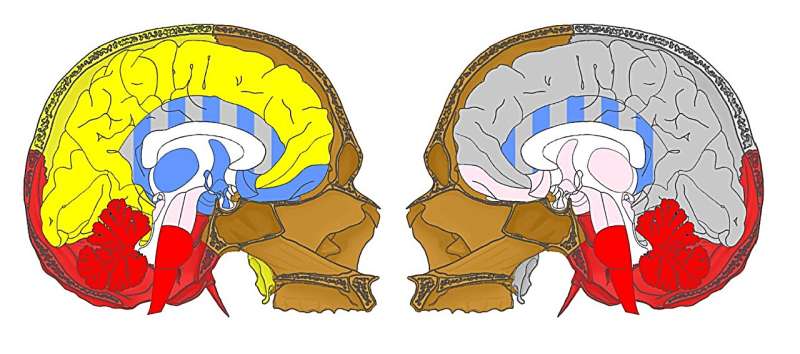This article has been reviewed according to Science X's editorial process and policies. Editors have highlighted the following attributes while ensuring the content's credibility:
fact-checked
proofread
Using network models to investigate the relationship between skull and brain

Emiliano Bruner and Tim Schuurman, of the Paleoneurobiology of Hominins Group at the Centro Nacional de Investigación sobre la Evolución Humana (CENIEH), have just published a paper in the Journal of Anatomy in which they study the spatial relationships between the human brain and skull using network analysis.
This method lets us quantify the role of each anatomical element in terms of its position and contact with others, offering a model to tell us which regions experience evolutionary links, or growth and development links, thanks to the influence of nearby elements.
Among skull elements, the sphenoid bone turns out to have the most complicated equilibrium, while among brain elements, the parahippocampal gyrus is the one presenting the most complex spatial relationships. The ethmoid bones are confirmed as a key element of the face and the cingulate gyrus as the bridge between the anterior and posterior regions, while the parietal bone turns out to undergo the effects of multiple elements of the cerebral cortex.
"These models are interesting in anatomy because they enable elucidating where the skull molds the brain and where it is that the brain molds the skull, from both the evolutionary and developmental perspectives," states Bruner.
Network analysis is used in many fields of research, and in neurobiology it is mainly employed to investigate cerebral connections. Its use in anatomy for researching spatial relationships is fairly recent.
The Paleoneurology Group has published other analyses applying the same method to elements of the cerebral cortex, to cytoarchitectonic Brodmann maps, to a complete model of the brain, and to the different blocks comprising its spatial assemblage.
More information: Tim Schuurman et al, An inclusive anatomical network analysis of human craniocerebral topology, Journal of Anatomy (2024). DOI: 10.1111/joa.14068





















